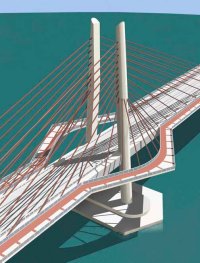
by Donald MacDonald.
Once it’s built, TriMet’s Milwaukie Light Rail bridge over the Willamette River will be the first in the country to carry only light rail and people on bikes and foot (no cars).
What will the actual bike and pedestrian facilities look like?
TriMet is currently working out design details with their new architect on the project, Donald MacDonald. At a recent bridge design meeting, MacDonald unveiled some interesting drawings of what the new bridge might look like. Also, TriMet’s bridge team offered details on the project to the City’s Bicycle Advisory Committee last month.
Jeff Jahn of PortlandArt.net was at a recent design meeting and has covered the design talks closely. He says MacDonald has been touting the bridge’s bike and ped facilities as possibly being some of the best in the world.
Jahn writes:
“…with bike and pedestrian lanes on both the north and south sides it has a shot at being the best (and only) bike, pedestrian and mass transit span in US. MacDonald, seemed positive that it could be the world’s top ped/cycling bridge.”
Jahn was kind enough to send over two more drawings of the bike/ped facilities by MacDonald. In the drawings (below), you’ll note that he has the path at 14 feet wide, evenly split between bike and ped traffic. For comparison, the Hawthorne — which some consider the busiest bike bridge in the country — is only 10.5 feet wide.
MacDonald’s drawings also show an understanding of the importance of separating bike and pedestrian traffic (something that is an ongoing problem for the Hawthorne Bridge). In one “scheme” he has the ped path raised up four inches. In the other, he uses a different surface treatment to visually separate the lanes. In each scheme, MacDonald has the bike/ped facility separated from the transit lane with a multi-foot buffer, cables, and two guard rails.
Here are the drawings:


If I had to choose, my preference would be for not having a raised platform for the walking area. I think it could cause people on bikes to crash and it would make it more difficult to use the full 14-feet when no people are present. It’s also important to keep in mind that a seven foot wide bikeway would allow two people to ride comfortably side-by-side.
To set design parameters for the bike/ped facility, TriMet staffers said they did a demand analysis led by Metro, with help from City of Portland Bike Cooordinator Roger Geller. They looked at three different demand scenarios and mode splits with a thought to match Portland’s aspirational plans for bike use (Climate Action Plan says 20% mode share for bikes by 2030) and reductions in transportation emissions (down 50% by 2030).
The Hawthorne Bridge currently has about 8,000 bike trips per day and that jibes with TriMet’s mid-range estimate of 8,300 trips a day for their new bridge.
The Bicycle Advisory Committee hoped for more than 14 feet, citing the congestion problems on the Hawthorne which is just a few feet narrower. But, after realizing that’s as wide as TriMet would go, the committee members decided to write a letter in support of 14 feet.
Learn more at Jahn’s Portland Art blog, the Portland Architecture blog or on TriMet’s official project website. You can also attend the next bridge design forum and offer your feedback:
-
Bridge Design Forum
Friday, July 24, Noon-1 p.m.
AIA Portland (403 NW 11th Ave.)
Note: Please RSVP directly to AIA Portland if you plan to attend. RSVP online here.

